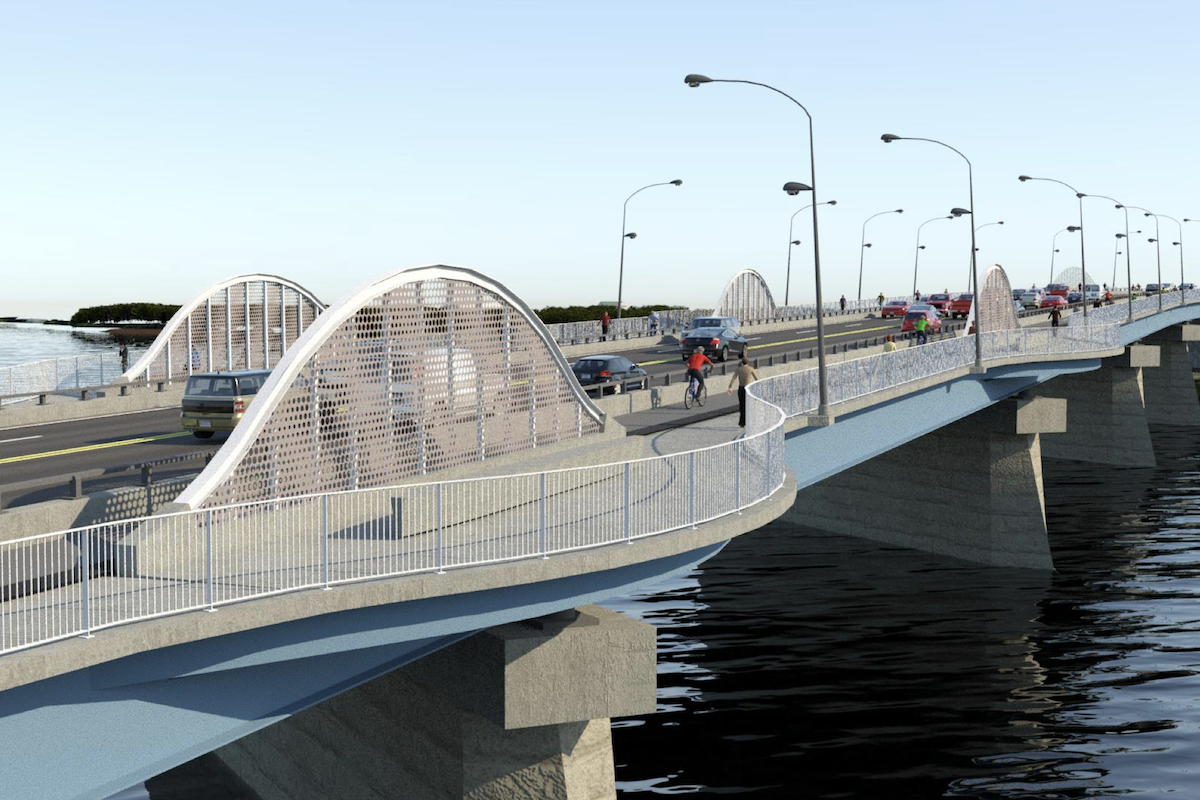A major Caltrans undertaking, the I-8 Pavement Replacement Project, is rehabilitating the concrete pavement along a 10-mile stretch of the eastbound lanes of I-8 between Viejas Creek in the town of Alpine and Pine Valley Bridge in an unincorporated area of San Diego County. This project will extend the service life of this portion of the highway by replacing aged pavement and providing other road-enhancing features along a section that has an average traffic volume of approximately 100,500 vehicles per day.
The extensive project, which began construction in June 2022, is scheduled to be complete in March 2024. The total project cost is $57.6 million, including support and construction costs. This is a State Highway Operation and Protection Program (SHOPP) funded project; SHOPP project funding is a mixture of Federal and State funds, including the Road Maintenance and Rehabilitation Account created by Senate Bill 1 (SB 1), California’s Road Repair and Accountability Act of 2017.
Caltrans Project Manager Malikyar Abdul explains the importance of Interstate 8 to the state.
“The eastern portion of I-8 beyond the urban area is primarily an inter-regional route used for goods movement, and for access to the mountain and desert recreational areas. Interstate 8 provides access between San Diego, El Centro, Calexico, Yuma, and other desert communities.

| Your local Case Construction Equipment Inc dealer |
|---|
| Beauregard Equipment |
| Monroe Tractor |
“In addition, I-8 is the primary route used by Imperial County agricultural producers to transport their products to San Diego County areas. In turn, I-8 provides access to suppliers of the agricultural support industries, and also connects distribution centers and consumers between the San Diego region and the Mexicali/Calexico region and beyond. The county’s agricultural products include cotton, sugar, beets, alfalfa, and table vegetables such as asparagus, broccoli, and carrots. Most of these perishable products are transported during seasonal peak periods as crops are harvested.
“Interstate 8 has been designated by Caltrans District 11 as a State Highway impacted by the North American Free Trade Agreement (NAFTA). The portion of I-8 from I-5 to the Arizona border is a designed route in the National Network for Surface Transportation Assistance Act (STAA) for the trucks. The segment of I-8 from Interstate 15 in San Diego County to the future junction with State Route 7 east of El Centro is included in the Statewide List of Lifeline Routes. A lifeline route is a route that is deemed so critical to emergency response/lifesaving services of a region or the state that it must remain open immediately following a major earthquake, or for pre-planning for detour and emergency response activities.”
- Continuously Reinforced Concrete Pavement (CRCP) concrete lane replacement of the number 2 and number 3 eastbound lanes and outside shoulder
- Individual slab replacement of remaining lanes, ramp, and shoulder coldplane and overlay
- Guardrail upgrade to Midwest Guardrail System (MGS)
- Bridge rail upgrade
- Culvert rehabilitation
- Stormwater measure Best Management Practices (BMP) construction in the median
The I-8 Pavement Replacement Project was designed by Caltrans staff. Granite Construction of Watsonville, California, is the primary contractor.
The project has been structured into five stages, each with multiple phases. Stage 1 was complete in early 2023; the second and third phases are scheduled for completion by the end of 2023. Granite Construction Project Manager Gerald Johnson details each of the project’s stages, explaining, “Stage 1 consisted of widening, milling, and filling the inside shoulder with new temporary hot mix asphalt (HMA), removing and replacing the approach and departure slabs of several bridges along the inside shoulder, replacing the existing barrier rail, and removing and replacing the 1,000-foot number 2 lane on either side of the bridges.
“Stage 2 consists of removing and replacing 3.5 miles of the existing number 3 jointed plain concrete pavement (JPCP) lane and the HMA shoulder and replacing them with new CRCP. Stage 3 builds on the second stage by removing 3.5 miles of existing numbers 2 and 3 existing JPCP lanes and the HMA shoulder and replacing them with new CRCP. Additionally, the existing approach and departure slab will be removed and replaced in this stage.
“Stage 4 consists of removing and replacing an additional 3.5 miles of existing numbers 2 and 3 JPCP lanes and the HMA shoulder and replacing them with new CRCP and removing and replacing the existing approach and departure slab.
“And finally, Stage 5 will include milling and overlaying the outside and inside shoulder with HMA, milling and overlaying the Alpine Overlook parking lot, the on-ramps and off-ramps at East Willows and 8/79 Japatul Valley Road, and removing the existing striping and replacing with new striping. During this phase, we will demo the existing concrete and HMA and process the material by crushing and reusing the material for Class 2 base.”
CRCP is a process of placing steel reinforcing bars within the concrete along the entire length of the lanes. CRCP naturally forms tight transverse cracks to evenly transfer loads. The result is a continual, smooth-riding surface capable of withstanding the heaviest loads and the most adverse environmental conditions. The life span for CRCP pavement may be up to 70 years, far exceeding existing road surfaces.
Abdul comments, “In addition to providing a 70-year life expectancy as opposed to regular concrete, CRCP was also the preferred choice using the life cycle cost analysis. It showed that the costs of maintaining is the lowest and also keeps maintenance projects at bay, thus resulting in safety for highway workers and traveling public.”
Johnson adds, “CRCP will help prevent stress cracks from developing. This is critical for the area's wide range of temperatures.”
“The main impacts of the pandemic were related to materials and labor. Pandemic restrictions created a backlog at the southern border between Mexico and California. This has delayed the importing of washed concrete sand that is imported from Mexico to our suppliers in California. Additionally, our concrete supplier has had trouble finding sufficient drivers for their mixer trucks.
“On a positive note, the project staging originally had multiple stages that overlapped and would require the contractor to close one lane at a time and come back to areas that were previously closed to complete the parallel lanes. The new staging allowed for the lane closure to be set up and left in place for the duration of the stage. Once we completed a stage, the area would then be given back to the public without the need for us to come back to the area.”
In summarizing the project, Abdul states, “The eastbound lanes of this segment were experiencing deterioration and cracks along the outside lanes. The pavement was originally built in the late 60’s and was reaching its life expectancy. Maintaining and multiple grinding for smoothness was already performed over time. Replacing these lanes with CRCP will definitely benefit our traveling public and the safety of our maintenance force, since this type of pavement will last up to 70 years and will not require maintenance. Also, upgrading of other assets in this project will improve safety and performance of the overall facility.”
- Caltrans
- Granite Construction
- CalMex Engineering (hot mix asphalt)
- CMC Rebar
- ACE Fence
- Sequoia Consultants
- Maneri Traffic Control
- Statewide Stripes, Inc.
- Global Road Sealing, Inc.
- Traffic Loops Crackfilling
- DRS Rebars
- 39,300 cubic yards removal of existing concrete and base
- 10 miles of new roadway
- 38,600 tons of HMA (Type A)
- 20,700 cubic yards Class 2 Base
- 44,100 cubic yards of CRCP
- 18,510 linear feet of 3-inch and 4-inch under and edge drain













































































